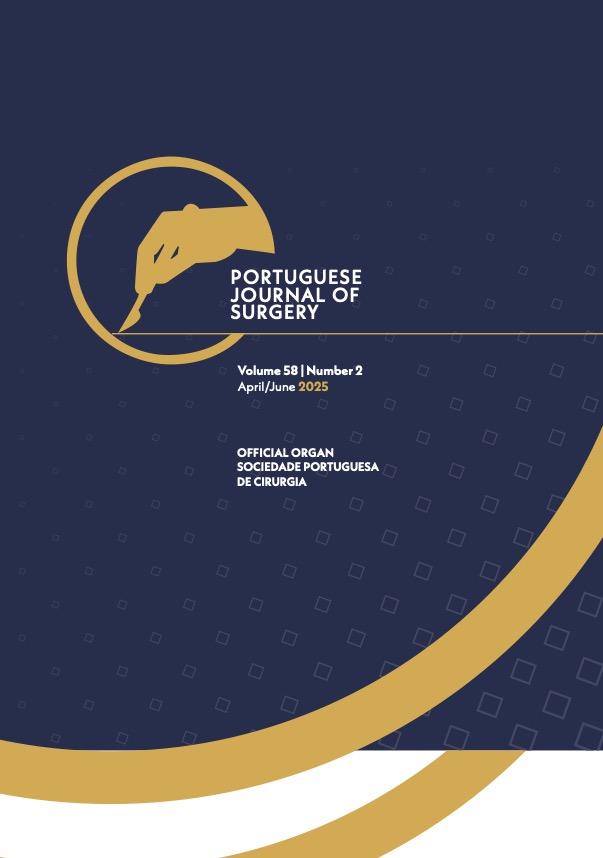Median Arcuate Ligament Syndrome (Dunbar Syndrome): The Importance of the Pre-Operative Study in Surgical Planning
DOI:
https://doi.org/10.34635/rpc.1102Keywords:
Celiac Artery/surgery, Median Arcuate Ligament Syndrome/diagnostic imaging, Median Arcuate Ligament Syndrome/surgeryAbstract
The median arcuate ligament syndrome, also known as Dunbar syndrome, is caused by stenosis of the celiac trunk due to compression by diaphragmatic fibres. The incidence of this condition remains unclear and its clinical presentation is multifarious. Diagnosis is established by angio-computed tomography to determine the extent of stenosis and the existence or not of collateral circulation. Surgical intervention remains the favoured treatment. We present the case of a 40-year-old man diagnosed with a cephalopancreatic neuroendocrine tumour proposed for a pancreatoduodenectomy. Preoperative imaging studies revealed significant celiac-mesenteric collateral circulation, raising doubts about whether it was caused by a celiac trunk agenesis versus a median arcuate ligament syndrome. This finding would significantly influence the choice of surgical strategy, particularly the need for vascular anastomoses or not. We hereby present its intraoperative findings and the surgical solution, enhancing the importance of the preoperative imaging studies.Downloads
References
Iqbal S, Chaudhary M. Median arcuate ligament syndrome (Dunbar syndrome). Cardiovasc Diagn Ther 2021;11:1172-6. doi: 10.21037/cdt-20-846
Goodall R, Langridge B, Onida S, Ellis M, Lane T, Davies AH. cite_start. Median arcuate ligament syndrome: A systematic review. J Vasc Surg. https://www.google.com/search?q=2018; 67:142-50.
Baskan O, Kaya E, Gungoren FZ, Eral C. Compression of the celiac artery by the median arcuate ligament multidetector computed tomography findings and characteristics. Can Assoc Radiol J 2015;66:272-6.
Hou B, Zhang H, Li X, Guo W, Yang J. Prevalence and imaging findings of celiac artery compression syndrome in a retrospective review of 1132 consecutive abdominal multidetector computed tomography scans. Medicine. 2017; 96: e7828.
Heo S, Kim HJ, Kim B, Lee JH, Kim J, Kim JK Clinical impact of collateral circulation in patients with median arcuate ligament syndrome. Diagn Interv Radiol. https://www.google.com/search?q=2018; 24: 181-6
Arazinska A, Polguj M, Wojciechowski A, Trebinski q, Stefanczyk L. Median arcuate ligament syndrome: predictor of ischemic complications? Clin Anat. 2016;29:1025-30
Reilly LM, Ammar AD, Stoney RJ, Ehrenfeld WK. Late results following operative repair for celiac artery compression syndrome. J Vasc Surg. 1985;2:79-91.
Karamanidi M, Chrysikos D, Samolis A, Protogerou V, Fourla N, Michalis I, Papaioannou G, Troupis T. Agenesis of the coeliac trunk: a case report and review of the literature. Folia Morphol. 2021;80:718-21. doi: 10.5603/FM.a2020.0093.
Giron de Velasco-Sada P, San Norberto García EM, Fuentes Valderrama G. Agenesis of the celiac trunk: case report and review of the literature. Radiología. 2016;58:416-9.
Loffroy R, Guiu B, Cercueil JP, Lepage C, Cheynel N. Agenesis of the celiac trunk: anatomic variants, clinical features, and diagnosis. Am J Roentgenol. 2007;188:1606-13.
Di Mizio R, Scaglione M, Scialpi M, Angelelli G. Agenesis of the celiac trunk: a systematic review of the literature. Quantitative Imaging Med Surg. 2019; 9:541-7.
Ahluwalia N, Nassereddin A, Futterman B. Anatomy, Abdomen and Pelvis, Celiac Trunk. In: StatPearls. Treasure Island: StatPearls Publishing, 2022.
Downloads
Published
Issue
Section
License
Copyright (c) 2022 Portuguese Journal of Surgery

This work is licensed under a Creative Commons Attribution-NonCommercial-NoDerivatives 4.0 International License.
Para permitir ao editor a disseminação do trabalho do(s) autor(es) na sua máxima extensão, o(s) autor(es) deverá(ão) assinar uma Declaração de Cedência dos Direitos de Propriedade (Copyright). O acordo de transferência, (Transfer Agreement), transfere a propriedade do artigo do(s) autor(es) para a Sociedade Portuguesa de Cirurgia.
Se o artigo contiver extractos (incluindo ilustrações) de, ou for baseado no todo ou em parte em outros trabalhos com copyright (incluindo, para evitar dúvidas, material de fontes online ou de intranet), o(s) autor(es) tem(êm) de obter, dos proprietários dos respectivos copyrights, autorização escrita para reprodução desses extractos do(s) artigo(s) em todos os territórios e edições e em todos os meios de expressão e línguas. Todas os formulários de autorização devem ser fornecidos aos editores quando da entrega do artigo.



